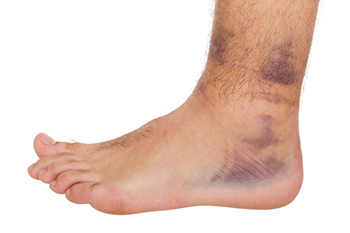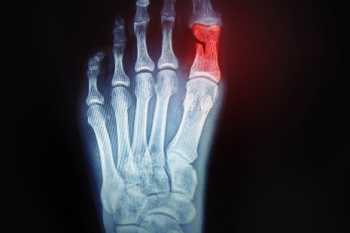Connect With Us
Blog
February 2025

Ball of foot pain, also known as metatarsalgia, is a common issue for runners. It typically occurs when excessive pressure is placed on the metatarsal bones, causing inflammation and discomfort in the area. Several factors can contribute to this condition, including improper footwear, running on hard surfaces, or poor running form. Tight calf muscles or an imbalance in foot mechanics can also increase the strain on the forefoot. The most common symptoms of metatarsalgia include burning pain, numbness, and a feeling of discomfort under the ball of the foot. This pain may worsen during or after running, especially when pushing off or bearing weight on the toes. If you have foot pain from running, it is suggested that you contact a podiatrist who can treat various foot conditions, and guide you on how to possibly prevent this issue.
Foot Pain
Foot pain can be extremely painful and debilitating. If you have a foot pain, consult with Cary Golub, DPM from New York. Our doctor will assess your condition and provide you with quality foot and ankle treatment.
Causes
Foot pain is a very broad condition that could be caused by one or more ailments. The most common include:
- Bunions
- Hammertoes
- Plantar Fasciitis
- Bone Spurs
- Corns
- Tarsal Tunnel Syndrome
- Ingrown Toenails
- Arthritis (such as Gout, Rheumatoid, and Osteoarthritis)
- Flat Feet
- Injury (from stress fractures, broken toe, foot, ankle, Achilles tendon ruptures, and sprains)
- And more
Diagnosis
To figure out the cause of foot pain, podiatrists utilize several different methods. This can range from simple visual inspections and sensation tests to X-rays and MRI scans. Prior medical history, family medical history, and any recent physical traumatic events will all be taken into consideration for a proper diagnosis.
Treatment
Treatment depends upon the cause of the foot pain. Whether it is resting, staying off the foot, or having surgery; podiatrists have a number of treatment options available for foot pain.
If you have any questions, please feel free to contact our offices located in Williston Park, and Long Beach, NY . We offer the newest diagnostic and treatment technologies for all your foot care needs.

An ankle sprain might seem like a minor injury, but without proper care, it can lead to long-term instability and recurring issues. The ligaments in the ankle are designed to provide support and balance, but a sudden misstep, awkward landing, or quick pivot can overstretch or tear them. Many people assume a sprain will heal on its own, but rushing back to activity too soon can cause weakness and increase the risk of reinjury. Persistent swelling, pain, or difficulty bearing weight may indicate a more severe sprain that requires medical attention. Strengthening and balance exercises help prevent future sprains, while wearing supportive footwear adds protection. Ignoring a sprain can lead to chronic instability, making future injuries more likely. If pain lingers or mobility is compromised, it is strongly suggested that you see a podiatrist to ensure proper healing and prevent long-term damage.
Ankle sprains are common but need immediate attention. If you need your feet checked, contact Cary Golub, DPM from New York. Our doctor can provide the care you need to keep you pain-free and on your feet.
How Does an Ankle Sprain Occur?
Ankle sprains take place when the ligaments in your ankle are torn or stretched beyond their limits. There are multiple ways that the ankle can become injured, including twisting or rolling over onto your ankle, putting undue stress on it, or causing trauma to the ankle itself.
What Are the Symptoms?
- Mild to moderate bruising
- Limited mobility
- Swelling
- Discoloration of the skin (depending on severity)
Preventing a Sprain
- Wearing appropriate shoes for the occasion
- Stretching before exercises and sports
- Knowing your limits
Treatment of a Sprain
Treatment of a sprain depends on the severity. Many times, people are told to rest and remain off their feet completely, while others are given an air cast. If the sprain is very severe, surgery may be required.
If you have suffered an ankle sprain previously, you may want to consider additional support such as a brace and regular exercises to strengthen the ankle.
If you have any questions please feel free to contact our offices located in Williston Park, and Long Beach, NY . We offer the newest diagnostic and treatment technologies for all your foot and ankle needs.

Early treatment of an infected foot wound is important for effective healing and preventing serious complications. Signs of infection include redness, swelling, warmth around the wound, persistent pain, pus, or a foul odor. Systemic symptoms like fever or chills may also occur. If you suspect an infection, it is important to keep the wound clean and dry. For individuals with diabetes or weakened immune systems, infection risks are higher, making vigilant care even more important. This is where a podiatrist can help. A podiatrist specializes in foot care and can assess the wound, provide antibiotics if necessary, and recommend advanced wound care treatments. They can also monitor the healing process, ensuring the infection does not spread. If your foot wound is infected or not healing, it is suggested that you make an immediate appointment with a podiatrist.
Wound care is an important part in dealing with diabetes. If you have diabetes and a foot wound or would like more information about wound care for diabetics, consult with Cary Golub, DPM from New York. Our doctor will assess your condition and provide you with quality foot and ankle treatment.
What Is Wound Care?
Wound care is the practice of taking proper care of a wound. This can range from the smallest to the largest of wounds. While everyone can benefit from proper wound care, it is much more important for diabetics. Diabetics often suffer from poor blood circulation which causes wounds to heal much slower than they would in a non-diabetic.
What Is the Importance of Wound Care?
While it may not seem apparent with small ulcers on the foot, for diabetics, any size ulcer can become infected. Diabetics often also suffer from neuropathy, or nerve loss. This means they might not even feel when they have an ulcer on their foot. If the wound becomes severely infected, amputation may be necessary. Therefore, it is of the upmost importance to properly care for any and all foot wounds.
How to Care for Wounds
The best way to care for foot wounds is to prevent them. For diabetics, this means daily inspections of the feet for any signs of abnormalities or ulcers. It is also recommended to see a podiatrist several times a year for a foot inspection. If you do have an ulcer, run the wound under water to clear dirt from the wound; then apply antibiotic ointment to the wound and cover with a bandage. Bandages should be changed daily and keeping pressure off the wound is smart. It is advised to see a podiatrist, who can keep an eye on it.
If you have any questions, please feel free to contact our offices located in Williston Park, and Long Beach, NY . We offer the newest diagnostic and treatment technologies for all your foot care needs.

A toe fracture is a break or crack in one of the bones of the toe, typically caused by direct trauma or pressure. This injury often occurs due to stubbing the toe, dropping something heavy on it, or participating in activities that involve repetitive stress. The common signs of a toe fracture include pain, swelling, bruising, and difficulty moving or bearing weight on the affected toe. In some cases, the toe may appear misaligned or deformed. To diagnose a toe fracture, a podiatrist will perform a physical examination and may take X-rays to evaluate the extent of the damage. Managing the symptoms generally involves rest and elevation. Mild pain relievers can help alleviate discomfort. For more severe fractures, immobilization through splinting or buddy taping is often used. In rare cases, surgery may be necessary to realign the bones and ensure proper healing. If you have fractured your toe, it is suggested that you contact a podiatrist who can properly treat this condition.
A broken toe can be very painful and lead to complications if not properly fixed. If you have any concerns about your feet, contact Cary Golub, DPM from New York. Our doctor will treat your foot and ankle needs.
What to Know About a Broken Toe
Although most people try to avoid foot trauma such as banging, stubbing, or dropping heavy objects on their feet, the unfortunate fact is that it is a common occurrence. Given the fact that toes are positioned in front of the feet, they typically sustain the brunt of such trauma. When trauma occurs to a toe, the result can be a painful break (fracture).
Symptoms of a Broken Toe
- Throbbing pain
- Swelling
- Bruising on the skin and toenail
- The inability to move the toe
- Toe appears crooked or disfigured
- Tingling or numbness in the toe
Generally, it is best to stay off of the injured toe with the affected foot elevated.
Severe toe fractures may be treated with a splint, cast, and in some cases, minor surgery. Due to its position and the pressure it endures with daily activity, future complications can occur if the big toe is not properly treated.
If you have any questions please feel free to contact our offices located in Williston Park, and Long Beach, NY . We offer the newest diagnostic and treatment technologies for all your foot and ankle needs.
Blog Archives
- 2025
- 2024
- 2023
- 2022
- 2021
- 2020

